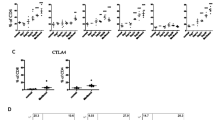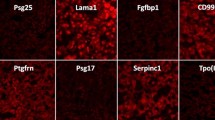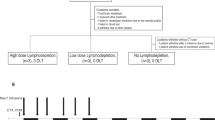Summary
Following inoculation with 1×106 MOPC-315 tumor cells, a single injection of a very low dose of melphalan (l-PAM, l-phenylalanine mustard), 0.75 mg/kg, cured most of the mice bearing a day 11 large primary tumor (20 mm) and metastases, but failed to cure mice bearing a day 4 nonpalpable tumor. Treatment of mice bearing a nonpalpable tumor with the very low dose of drug compromised the ability of the mice to respond effectively to the same low dose of drug when the tumor became large (day 12). However, a nonpalpable tumor could be eradicated by treatment of tumor bearers with a low dose of l-PAM, if it was present concomitantly with a large tumor on the contralateral side. A high dose of l-PAM, 15 mg/kg, cured mice bearing either a nonpalpable or a large tumor. The eradication of the tumor induced by the high dose of l-PAM appeared to be due solely to the tumoricidal effect of the drug. On the other hand, the eradication of the tumor by the low dose of l-PAM also required the participation of antitumor immunity of the host, since subsequent injection of antithymocyte serum abrogated the curative effect of the drug in most mice. Mice cured by a high dose of l-PAM were not resistant to subsequent lethal tumor challenge. In contrast, mice cured by the low dose of l-PAM were able to reject a tumor challenge of 300 times the minimal lethal tumor dose. The results obtained with l-PAM therapy are similar to the results that we had previously reported with cyclophosphamide therapy. Thus, the timing of therapy with a low dose of drug for mice bearing a MOPC-315 tumor is critical for successful therapy. Moreover, the selection of a low dose rather than a high dose of drug to eradicate a large tumor offers the advantage that it results in long-lasting potent antitumor immunity as a consequence of the participation of host antitumor immunity in the eradication of the tumor.
Similar content being viewed by others
References
Adler A, Altbaum I (1982) Development of resistance of MOPC-315 plasmacytoma after intralesional and intraperitoneal melphalan therapy of tumor-bearing BALB/c mice. I. Enhancement of in vivo rejection responses by combined chemotherapy-immunotherapy. J Natl Cancer Inst 68:963
Arai K, Spencer JS, Sohn M, Wallace HW (1979) Effect of hapten plus antihapten-tumor serum treatment on established rat fibrosarcoma. Cancer Res 39:6
Bocian RC, Ben-Efraim S, Mokyr MB, Dray S (1983) Melphalan-mediated immunomodulation of the antitumor cytotoxic response of spleens from mice bearing a large MOPC-315 plasmacytoma. Fed Am Soc Exp Biol 42:681
Borsos T, Bast RC Jr, Ohanian SH, Segerling M, Zbar B, Rapp HJ (1976) Induction of tumor immunity by intratumoral chemotherapy. Ann NY Acad Sci 276:565
Chassoux DM, Gotch FM, MacLennan ICM (1978) Analysis of synergy between cyclophosphamide therapy and immunity against a mouse tumor. Br J Cancer 38:211
Dray S, Mokyr MB (1983) Immunomodulation by cyclophosphamide and its effect on eradication of established tumors. In: Fudenberg H, Ambrogi F (eds) Frontiers in immunomodulation. Plenum Press, New York (in press)
Fefer A, Einstein AB, Cheever MA (1976) Adoptive chemoimmunotherapy of cancer in animals: A review of results, principles, and problems. Ann Acad Sci Fenn [Chem] 277:492
Fuji H, Mihich E, Pressman D (1977) Differential tumor immunogenicity of L1210 and its sublines. I. Effect of an increased antigen density on tumor cell surfaces on primary B cell responses in vitro. J Immunol 119:983
Fuji H, Mihich E, Pressman D (1979) Differential tumor immunogenicity of DBA/2 mouse lymphoma L1210 and its sublines. II. Increased expression of tumor-associated antigens on subline cells recognized by serologic and transplantation methods. J Natl Cancer Inst 62:1503
Furner RL, Mellett LB, Brown RK, Duncan G (1976) A method for the measurement of phenylalanine mustard in the mouse and dog by high-pressure liquid chromatography. Drug Metab Dispos 4:577
Greenberg PD, Cheever MA, Fefer A (1980) Detection of early and delayed anti-tumor effects following curative adoptive chemoimmunotherapy of established leukemia. Cancer Res 40:4428
Greenberg PD, Cheever MA, Fefer A (1981) Eradication of disseminated murine leukemia by chemoimmunotherapy with cyclophosphamide and adoptively transferred immune syngeneic Lyt-1+2− lymphocytes. J Exp Med 154:952
Hengst JCD, Mokyr MB, Dray S (1980) Importance of timing in cyclophosphamide therapy of MOPC-315 tumor-bearing mice. Cancer Res 40:2135
Hengst JCD, Mokyr MB, Dray S (1981) Cooperation between cyclophosphamide tumoricidal activity and host antitumor immunity in the cure of mice bearing large MOPC-315 tumors. Cancer Res 41:2163
Kleinerman ES, Zwelling LA, Schwartz R, Muchmore AV (1982) Effect of l-phenylalanine mustard, adriamycin, actinomycin D, and 4′-(9-acridinylamino) methanesulfon-m-anisidide on naturally occurring human spontaneous monocyte-mediated cytotoxicity. J Immunol 42:1692
Lubet RA, Carlson DE (1978) Therapy of the murine plasmacytoma MOPC 104E: Role of the immune response. J Natl Cancer Inst 61:897
Mathé G, Halle-Pannenko O, Bourut C (1977) Effectiveness of murine leukemia chemotherapy according to the immune state. Cancer Immunol Immunother 2:139
Mokyr MB (1982) Immunomodulation by cyclophosphamide and its effect on eradication of established tumors. PhD thesis. Rush University, Chicago, Illinois
Moky MB, Braun DP, Usher D, Reiter H, Dray S (1978) The development of in vitro and in vivo antitumor cytotoxicity in non-cytotoxic, MOPC-315 tumor-bearer, spleen cells “educated” in vitro with MOPC-315 tumor cells. Cancer Immunol Immunother 4:143
Mokyr MB, Hengst JCD, Przepiorka D, Dray S (1979) Augmentation of antitumor cytotoxicity of MOPC-315 tumor bearer spleen cells by depletion of DNP-adherent cells prior to in vitro immunization. Cancer Res 39:3928
Mokyr MB, Hengst JCD, Dray S (1982) Role of antitumor immunity in cyclophosphamide-induced rejection of subcutaneous nonpalpable MOPC-315 tumors. Cancer Res 42:974
Moore M, Williams DE (1973) Contribution of host immunity to cyclophosphamide therapy of a chemically-induced murine sarcoma. Int J Cancer 11:358
North RJ (1982) Cyclophosphamide-facilitated adoptive immunotherapy of an established tumor depends on elimination of tumor-induced suppressor T cells. J Exp Med 55:1063
Osborne DP, Katz DH (1977) The allogeneic effect on tumor growth. I. Inhibition of a murine plasmacytoma, MOPC-315, by graft-vs.-host reaction. J Immunol 118:1449
Preud'homme JL, Buxbaum J, Scharff MD (1973) Mutagenesis of mouse myeloma cells with ‘Melphalan’. Nature 245:320
Radov LA, Haskill SJ, Korn JH (1976) Host immune potentiation of drug responses to a murine mammary adenocarcinoma. Int J Cancer 17:773
Radov LA, Korn JH, Haskill JS (1976) Host immune potentiation of drug responses to a murine mammary adenocarcinoma. II. Effect of melphalan therapy on the host immune system. Int J Cancer 18:630
Rollinghoff M, Rouse BT, Warner NL (1973) Tumor immunity to murine plasma cell tumors. I. Tumor-associated transplantation antigens of NZB and BALB/c plasma cell tumors. J Natl Cancer Inst 50:159
Sladek NE (1977) Potentiation of the cytotoxic action of melphalan and ‘activated’ cyclophosphamide against cultured tumor cells by centrophenoxide. J Pharmacol Exp Ther 200:17
Tribalto M, Arcese W, Colombo R, Franchi A (1981) Chemotherapy in multiple myeloma. Review of recent experience. Recenti Prog Med 71:141
Yamamura Y, Proctor JW, Fischer BC, Harnaha JB, Mahvi TA (1980) Collaboration between specific anti-tumor immunity and chemotherapeutic agents. Int J Cancer 25:417
Author information
Authors and Affiliations
Rights and permissions
About this article
Cite this article
Ben-Efraim, S., Bocian, R.C., Mokyr, M.B. et al. Increase in the effectiveness of melphalan therapy with progression of MOPC-315 plasmacytoma tumor growth. Cancer Immunol Immunother 15, 101–107 (1983). https://doi.org/10.1007/BF00199699
Received:
Accepted:
Issue Date:
DOI: https://doi.org/10.1007/BF00199699




